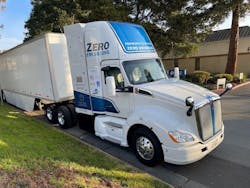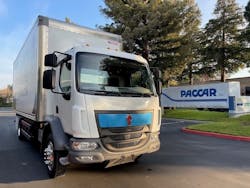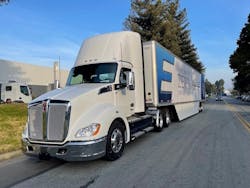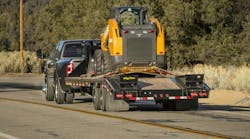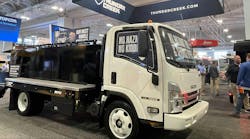In mid-January, Kenworth offered journalists a sneak peek at its upcoming line of battery-electric trucks for both vocational and long-haul applications. The trucks are an interesting harbinger of a zero-emissions future that lies just over the horizon for many fleets—including those engaged in vocational applications.
Editors note: This was originally reported in Heavy Duty Trucking magazine.
Electric trucks and hydrogen fuel cell trucks won’t be a good fit for every fleet. Given the impressive performance and capabilities exhibited by the vehicles Kenworth had on display at its Paccar Innovation Center located in Sunnyvale, California, however, it seems almost certain that a surprising number of fleets nationwide will give these zero-emissions vehicles (ZEVs) an honest appraisal and eventual deployment once they enter into mainstream production.
To highlight its current ZEV technology portfolio, Kenworth had three trucks on hand for test drives: a medium-duty KW270E electric truck; its flagship Class 8 ZEV, the Kenworth T680E; and a T680FCEV, the company’s hydrogen fuel cell tractor it is developing in a joint partnership with Toyota.
Kenworth T680E Specs
- Range: 150 miles
- Top speed: 65 mpg
- Power: 536 hp
- Torque: 1,623 lb.-ft.
- Battery pack: 396 kWh
- GVWR: 82,000 lb. including 2,000 lb. ZEV weight exemption for batteries
My first test drive of the morning was in the T680E heavy truck (top photo). As with all of Kenworth ZEV models, from the outside there’s nothing about the truck identifying it as a green vehicle. The same holds true when you climb up into the cab and settle in behind the steering wheel. There’s a key to start the truck, but you don’t turn it all the way and crank it as you do on a conventional diesel truck. You simply turn it to the “On” position and wait a heartbeat while all the vehicle systems boot up. When a green icon light next to the trip odometer flashes on, you know you’re ready to go. At that point, you twist the column-mounted transmission control knob to “D,” release the brakes, and step on the throttle.
The test model T680E was loaded to 67,000 pounds. But even with that weight in the trailer, acceleration from the Meritor e-powertrain was immediate, crisp, and powerful without any gear shifts at all. The e-drivetrain churns out an impressive 536 horsepower, delivered with zero powertrain vibrations rattling the cab. Those are big-bore engine horsepower numbers, in a truck that can quietly and smoothly pull away from even the strongest-pulling diesels available today because its electric drivetrain is so efficient. And all without burning up a single liquified dinosaur.
Also impressive is the truck’s regenerative braking system that captures the kinetic energy generated by the truck’s forward momentum and flows it back into the battery system. In practical terms, the system puts vastly less wear on brake friction material. Moreover, because all the kinetic energy is flowed back into the battery, it means that the truck’s advertised range of 150 miles on a single battery charge is actually a highly fluid number that will depend greatly on the route being run. In many instances, with good, sensible planning, it will be possible to extend the truck’s daily range significantly.
Kenworth K270E Specs
- Range: 100-200 miles
- Powertrain rating: 469 hp, 2,540 lb.-ft. torque
- Top speed: 65 mph
- Battery Pack: 141-282 kWh
- GVWR: 26,000 lb. and 33,000 lb.
My next drive was the Class 5 K270E all-electric cabover truck (below) featuring a Dana electric powertrain that puts out 469 horsepower. Its daily range varies between 100 and 200 miles, depending on route and application. These nimble little cabovers are Kenworth’s medium-duty workhorses and were among the first models it equipped with electric powertrain technology.
Again, starting the K270E is as simple as turning the key, waiting for all the onboard systems to boot up, releasing the parking brake, and taking off. It is astonishing how quickly the truck accelerates compared to a conventional diesel K270. Moreover, that power curve remains consistent no matter how fast you’re going. If you’re cruising at 40 mph and need to reach 60 mph in a hurry, that’s not going to be a problem for the K270E. The truck is also whisper-quiet, both at low speeds and highway speeds. The usual engine noise and powertrain vibrations are again simply nonexistent, which will pay dividends in terms of reduced driver fatigue and safety. Considering that these trucks will routinely operate in urban and last mile applications, their vastly quieter powertrains will greatly enhance situational awareness for drivers on busy city streets.
Kenworth T680 CEF hydrogen truck specs
- Range: 300 miles
- Top speed: 70 mph
- Power: 560 hp
- Refueling time: 15 minutes
- Battery pack: 12 kWh
- GCWR: 82,000 lb., including a 2,000 lb. ZEV weight exemption for battery packs
- Hydrogen tank capacity: 60 kg
- Payload capacity: 45,000 lb.
I was really looking forward to my last test of the day, because it was the first hydrogen fuel cell truck I’ve had an opportunity to take for a drive, after hearing about this emerging ZEV technology for several years now.
The T680FCEV (above) has a different appearance than a conventional T680. An additional area has been added to the back of the cab—looking a bit like a small sleeper cab—where the hydrogen fuel tanks are housed. This rear area isn’t large, however, and should not dramatically affect trailering capability, payload, or typical fifth-wheel/trailer gap configurations.
Startup is exactly the same as in the T680E, and acceleration was once again crisp and authoritative as the truck gained speed. The T680FCEV isn’t quite as smooth as its all-electric sibling, however, due to a conventional, four-speed, automated transmission. Even so, there were still familiar shift points as the truck accelerated or slowed down. Of all the North American OEMs, Paccar has been steadfast in using conventional automated gearboxes on some of its ZEV models, in contrast to infinite-torque electric drivetrains that have no shift points at all. Both systems work well with electric drivetrains, Paccar engineers say. And they want to keep options open for fleets once these vehicles go into production.
The regenerative braking system on the hydrogen truck wasn’t as aggressive as the one on the electric, however, because there’s no need to put energy back into the battery the way there is on the T680E. This truck carries liquified hydrogen as its fuel, after all, and converts it to electrical energy on the go. The T680FCEV does have a small battery onboard to “help out” by adding additional power to the drivetrain when needed (on a steep grade, for example). But because its power demands are much lower than on the all-electric T680E, a powerful regenerative braking system isn’t a priority.
The T680FCEV is also louder than the all-electric version of the truck. There’s a noticeable whine on the road emitted by various air pumps on the vehicle. But Kenworth engineers noted that this is a prototype truck and that those pumps would obviously be muted considerably on a production version of the tractor.
The overall feel of the truck was much like that of a conventional T680 in terms of comfort, safety, and handling—absent the usual engine and powertrain noise. It accelerates well thanks to the 560 horsepower the powertrain cranks out. Kenworth says the truck can cruise for 300 miles at 70 mph and only has a 15-minute refueling time when you need to replenish the hydrogen tanks.
